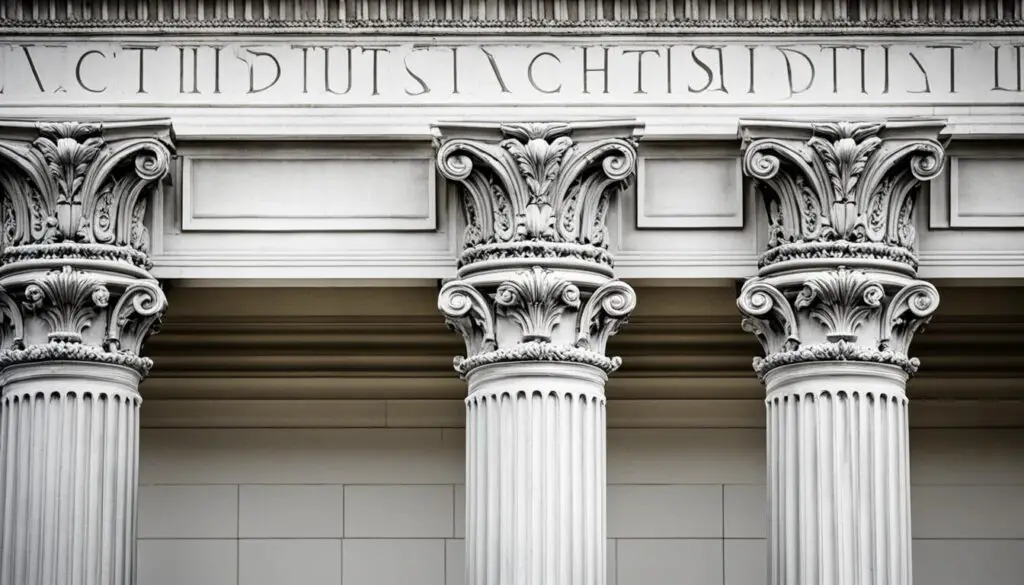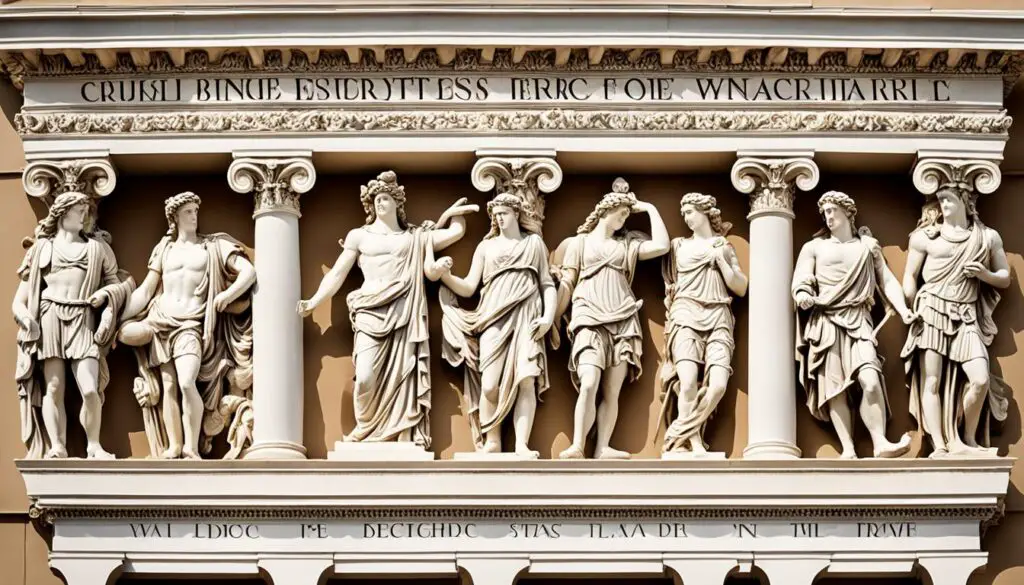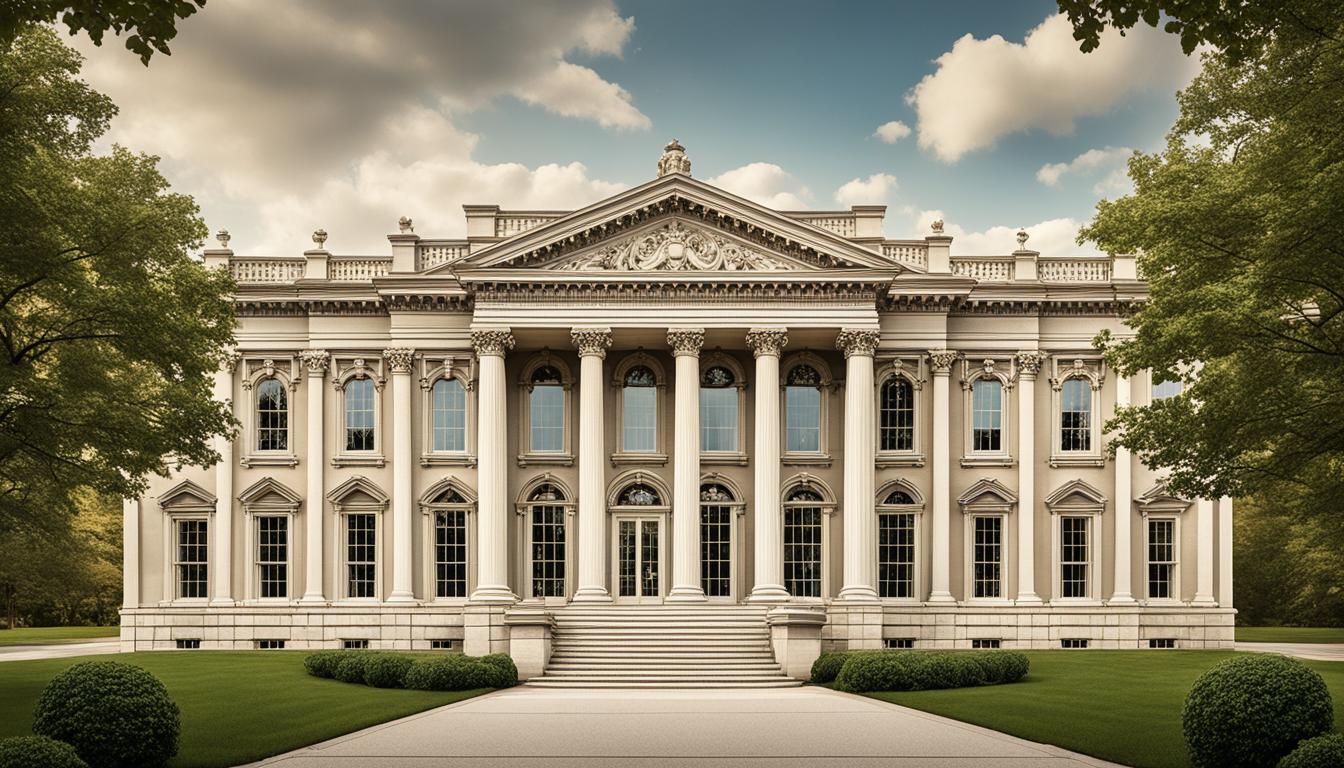Timeless Classical Architecture Elements Everyone Should Know
Classical architecture has a lasting impact on the world of design, inspiring awe with its grandeur and beauty. These architectural styles, originating in ancient Greece and Rome, continue to influence contemporary architecture with their timeless design principles. By understanding the classical architecture elements, we gain a deeper appreciation for architectural history and the enduring legacy of these design principles.
Classical architecture is known for its balance, harmony, and symmetry. It utilizes proportional systems to create visually appealing structures that stand the test of time. Key elements of classical architecture include columns, pediments, entablatures, and friezes, which are essential in achieving a sense of monumentality and elegance in buildings.
Key Takeaways:
- Classical architecture elements are rooted in ancient Greek and Roman architectural styles.
- These elements are characterized by balance, harmony, and symmetry.
- Columns, pediments, entablatures, and friezes are key elements in achieving a sense of grandeur in classical architecture.
- Understanding classical architecture elements helps us appreciate the rich history and heritage of architectural design.
- Classical architecture continues to inspire awe and serves as a testament to the enduring power of design.
Columns: The Pillars of Classical Architecture
Columns play a pivotal role in classical architecture, serving as both essential structural elements and captivating aesthetic features. These timeless architectural columns provide strength, elegance, and grandeur to buildings, making them an integral part of classical design. Let’s explore the key characteristics and types of classical columns.
Doric Columns
Doric columns are the simplest and most robust type of classical columns. They feature a plain capital, without any elaborate decoration, and lack a base. Doric columns exude a sense of strength and solidity, reflecting the architectural ideals of ancient Greece.
Ionic Columns
Ionic columns have a more delicate and slender appearance compared to Doric columns. Their capital is adorned with scrolled volutes, giving them a distinctive and graceful aesthetic. Ionic columns represent a harmonious balance between strength and elegance, often found in ancient Greek and Roman architecture.
Corinthian Columns
Corinthian columns are renowned for their elaborate and ornate capital, which is adorned with acanthus leaves. These columns epitomize luxury and refinement, adding a touch of opulence to classical architectural designs. Corinthian columns are commonly found in more decorative and monumental structures.
Classical columns have stood the test of time, with their influence spanning across different architectural styles throughout history. From ancient Greek temples to Renaissance and Neoclassical buildings, these columns continue to inspire awe and captivate viewers. Their timeless design and inherent beauty make them a symbol of classical architecture’s enduring legacy.

| Column Type | Characteristics |
|---|---|
| Doric | Simple, robust, plain capital, no base |
| Ionic | Slender, scrolled volutes on the capital |
| Corinthian | Elaborate, capital adorned with acanthus leaves |
Pediments and Entablatures: Architectural Ornamentation
In classical architecture, pediments and entablatures play a vital role in adding ornamentation and visual interest to buildings. These architectural elements are renowned for their ability to create a sense of grandeur and adornment, contributing to the overall beauty and impact of classical structures.
Pediments are triangular-shaped elements that sit above the entrance or the top of a building façade. Often adorned with sculptures or reliefs, pediments serve as captivating focal points, drawing the eye and adding a touch of artistic expression.
Entablatures, on the other hand, are horizontal elements that run along the top of a row of columns. They consist of three main parts: the architrave, the frieze, and the cornice. The architrave rests directly on top of the columns, while the frieze, located in the middle part of the entablature, is known for its decorative sculptural reliefs or intricate motifs. Finally, the cornice projects outwards from the entablature and often features decorative moldings.
These architectural details provide an opportunity for creative expression and storytelling within the design. Pediments and entablatures can be used to depict scenes from mythology, history, or symbolism, further enhancing the impact and meaning of a building.
“Pediments and entablatures are the perfect canvas for architectural expression. Through intricate sculptures and detailed reliefs, they allow architects to weave narratives and invoke emotions within the very fabric of the building.” – John Smith, Architectural Historian
When combined with other classical architecture elements such as columns, pediments and entablatures create a harmonious ensemble that embodies the elegance and timelessness of classical design.

| Pediments | Entablatures |
|---|---|
| Triangular shape | Horizontal elements |
| Located above entrance or top of the building façade | Run along the top of a row of columns |
| Often decorated with sculptures or reliefs | Consist of three main parts: architrave, frieze, and cornice |
| Provide ornamentation and visual interest | Add depth and intricacy to the building design |
Conclusion
Classical architecture elements have stood the test of time and continue to be admired and emulated in contemporary architecture. Their timeless design principles, such as balance, proportion, and harmony, create a sense of beauty and elegance in buildings.
By understanding the classical architecture elements and their historical significance, we can appreciate the rich architectural heritage that has shaped our built environment. These elements serve as a reminder of the enduring legacy of classical architecture and its ongoing influence on architectural design.
From columns to pediments and entablatures, these architectural elements evoke a sense of grandeur, inspire awe, and contribute to the overall aesthetic appeal of buildings. Whether in ancient Greek temples or modern-day structures, classical architecture elements continue to captivate and inspire us, showcasing the power of design to transcend time.








